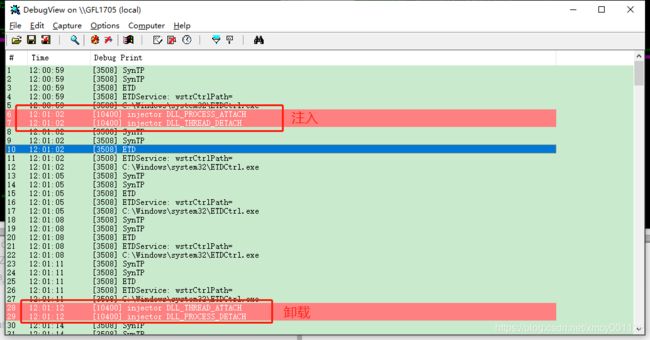解决注入器在DLL的入口函数中创建线程时卡死的问题
文章目录
- 问题描述
- 验证过程
-
- 创建动态库项目
- 动态库中启动线程
-
- 错误的用法
- 正确的用法
- 附:注入器代码
-
- inject_tool.h
- inject_tool.cpp
- 更多
问题描述
根据网上的教程,写了一个注入器的实现:

但是我发现注入后无法卸载,经过一系列的排除法验证后,最终确定了原因。
先上代码,动态库DllMain中使用线程的正确姿势:
#include 验证过程
创建动态库项目
BOOL APIENTRY DllMain(HMODULE hModule,
DWORD ul_reason_for_call,
LPVOID lpReserved
) {
switch (ul_reason_for_call) {
// 注意,默认的case不带break,会一直往下执行。其次break需要用{}包起来,否则作用域就是switch了
case DLL_PROCESS_ATTACH: {
OutputDebugStringW(L"injector DLL_PROCESS_ATTACH");
break;
}
case DLL_THREAD_ATTACH: {
OutputDebugStringW(L"injector DLL_THREAD_ATTACH");
break;
}
case DLL_THREAD_DETACH: {
OutputDebugStringW(L"injector DLL_THREAD_DETACH");
break;
}
case DLL_PROCESS_DETACH: {
OutputDebugStringW(L"injector DLL_PROCESS_DETACH");
break;
}
}
return TRUE;
}
-
使用od加载微信。然后点击注入,查看OD(附加后点击e,可查看加载的库)中动态库是否已成功加载。如下图,没有问题,已成功加载。

-
步骤4中,我点击了卸载,故输出了卸载的2个log,刷新一下OD,发现该动态库已经不在了。
动态库中启动线程
错误的用法
通过上面的验证,我们初步明白了注入和卸载的执行顺序。有时候,我们可能会在DLL中启动Socket监听,故需要新启动一个线程去做这件事情,我使用了标准线程库std::thread,代码如下:
BOOL APIENTRY DllMain(HMODULE hModule,
DWORD ul_reason_for_call,
LPVOID lpReserved
) {
switch (ul_reason_for_call) {
case DLL_PROCESS_ATTACH: {
OutputDebugStringW(L"injector DLL_PROCESS_ATTACH");
// 这里创建线程,模拟Socket监听线程
std::thread t([]() {
while (g_run_falg_) {
std::this_thread::sleep_for(std::chrono::seconds(1));
OutputDebugStringW(L"injector thread run");
}
OutputDebugStringW(L"injector thread exit");
});
t.detach();
break;
}
// ...
}
此时,我通过注入器再注入后,发现无法再卸载,Log也只有DLL_PROCESS_ATTACH,DLL_THREAD_ATTACH没有执行,说明被卡住了。后经过搜索验证,更换了std::thread后解决,具体见:正确的用法。
正确的用法
动态库DllMain入口中,线程正确启动和退出的姿势如下:
#include 附:注入器代码
inject_tool.h
#ifndef _INJECT_TOOLS_4B2B684A_9CA6_4A9E_B7C0_9EC427D54FD7_
#define _INJECT_TOOLS_4B2B684A_9CA6_4A9E_B7C0_9EC427D54FD7_
#include inject_tool.cpp
#include "stdafx.h"
#include "inject_tools.h"
#include 更多
相关代码我已经放在了 https://github.com/xmcy0011/study-trace

